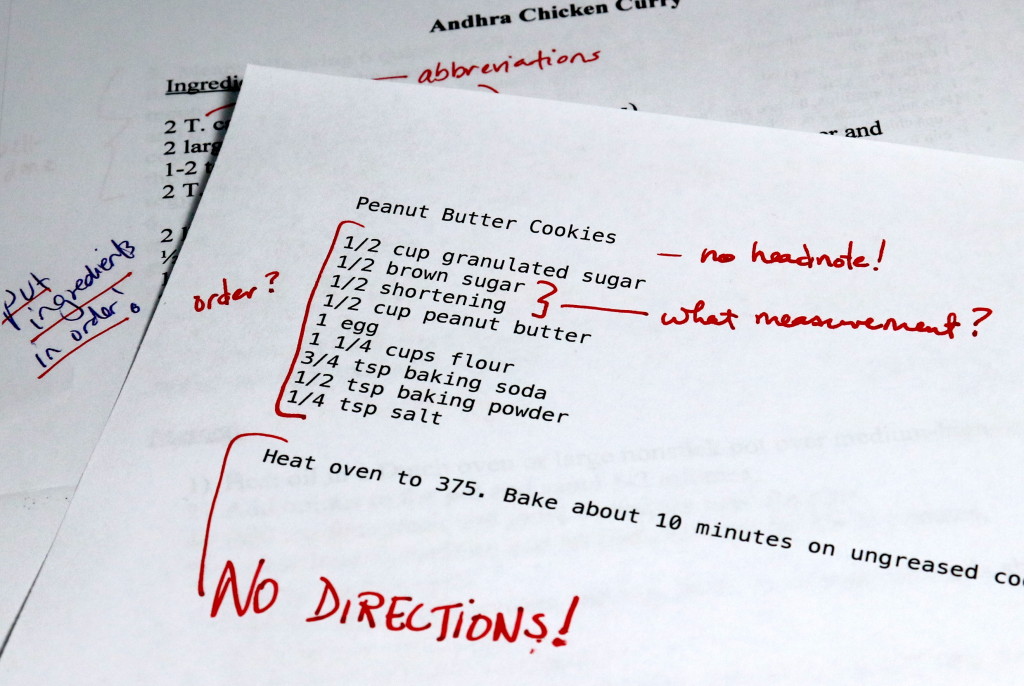
Recently I had the opportunity to attend a recipe writing workshop sponsored by the Austin Food Blogger Alliance. Considering that a lot of what I do here is create various flavors of fudge and then publish the recipes, I figured this workshop would be help me out a lot.
As a technical writer, I know how to write instructions that tell people what to do. But I found out there are some interesting twists to writing recipes.
The first thing you need to determine is your audience and your point of view. I usually tell family stories with my recipes, so I expect my audience to be people who like fudge or people who like my family stories.
Then you should format your recipes in a standard manner:
- Title
- Headnote
- Yield
- Ingredient list
- Method/directions
- Copyright information
The title itself should be specific, creative, SEO-appropriate, and definitely not confusing or vague. You want people to be able to find your recipes. For example, Stone Fruit Ice Cream might be a little vague, because not everyone knows that stone fruit means fruit with a pit – peaches, cherries, plums, and so on.
The intro/headnote needs to pull people in with a description of your recipe. It can be just a couple of sentences. You can use it to mention what to serve the recipe (wine, cheese, etc.) or you can use it to explain a tricky technique or unusual ingredients. You can also include some historical background.
The yield is how much the recipe makes – servings, weight, volume – whatever kind of measurement is appropriate for the dish.
The ingredients come next. You should standardize on one way of writing your measurements. Do you use 1 teaspoon or 1 tsp? Do you use 1 cup or 1C? Creating a blog style guide can help you keep recipes consistent.
Be careful of which words to use and the order of the words. Will your audience know what sauté and blanch mean? Will you put the action or vessel first? For example:
- Vessel first: In a 3-quart pot, bring 2 cups of water to a boil.
- Action first: Bring 2 cups of water to a boil in a 3-quart pot.
Also, you need to be very careful with measurements. Is it 1 cup cilantro, chopped, or 1 cup of chopped cilantro. These two measurements are very different.
The ingredients are arranged in the order used, and can include basic prep information. For example: 4 large carrots, peeled, or 2 cups light brown sugar (packed). You can also include measurements such as weight or volume (1 cup or 8 oz), or both when helpful, and packages sizes when appropriate. Make sure you use all volume or all weight in the same recipe for consistency.
If all the ingredients go in a bowl, list from larger volume to smaller. If the measurements are the same, place them in alphabetical order. You can also give substitutions when helpful. If there are lots of ingredients, consider using component headers (“salsa” or “tacos”).
When you write the directions, you should list the steps in order and put a hard return between steps. Also, describe what the end result is, not just the cooking time. When giving a cooking time, don’t just say “about 15 minutes,” give a time range.
Finally, keep the instructions as clear and as short as possible.
At the end of the recipe, if it is an original recipe, consider placing a copyright statement. Ethically speaking, you shouldn’t copy someone else’s recipe, make a small change in an ingredient, such as 1/2 tablespoon of butter instead of 3/4 tablespoon, and then claim a copyright. That’s not really a new recipe. The instructors suggested that you should research at least three recipes to see what variations are there, make your own version, and then Google it to be sure.
I learned so much in that one hour. I can’t wait to start using the suggestions made in class. Thanks to Shef and Serena for giving up their time to teach us how to right recipes, and thanks to the Austin Food Blogger Alliance for sponsoring the class. Thanks to the Sustainable Food Center for providing meeting space.
